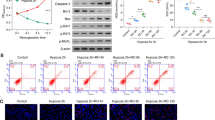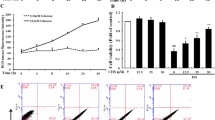Abstract
Purpose
Ischemic postconditioning (IPostC) alleviates myocardial ischemia/reperfusion (IR) injury, but the protective effect is lost during diabetes. PH domain leucine-rich repeat protein phosphatase 1 (PHLPP1) is able to inactivate Akt. Our previous study found that PHLPP1 expression was upregulated in diabetic hearts. We presumed that the attenuation of myocardial injury by IPostC might be hindered by PHLPP1 overexpression in diabetic animals.
Methods and results
Nondiabetic and diabetic mice were subjected to 45 min of ischemia followed by 2 h of reperfusion with or without IPostC. H9c2 cells were exposed to normal or high glucose and were subjected to 4 h of hypoxia followed by 4 h of reoxygenation with or without hypoxic postconditioning (HPostC). IPostC attenuated postischemic infarction, apoptosis, creatine kinase-MB, and oxidative stress, which were accompanied by increased p-Akt and decreased PHLPP1 expression and p-Mst1 in nondiabetic but not in diabetic mice. PHLPP1 knockdown or an Mst1 inhibitor reduced hypoxia/reoxygenation (HR)-induced cardiomyocyte damage in H9c2 cells exposed to normal glucose, but the effect was abolished by a PI3K/Akt inhibitor. HPostC attenuated HR-induced cardiomyocyte injury and oxidative stress accompanied by increased p-Akt as well as decreased PHLPP1 expression and p-Mst1 in H9c2 cells exposed to normal glucose but not high glucose. In addition, HPostC in combination with PHLPP1 knockdown or PHLPP1 knockdown alone reduced cell death and oxidative stress in H9c2 cells exposed to high glucose, which was hindered by PI3K/Akt inhibitor.
Conclusion
IPostC prevented myocardial IR injury partly through PHLPP1/Akt/Mst1 signaling, and abnormalities in this pathway may be responsible for the loss of IPostC cardioprotection in diabetes.








Similar content being viewed by others
Data Availability
The data used to support the findings of this study are included within the article.
References
Virani SS, Alonso A, Aparicio HJ, et al. Heart disease and stroke statistics-2021 update: a report from the american heart association. Circulation. 2021;143(8):e254–743.
Frohlich GM, Meier P, White SK, Yellon DM, Hausenloy DJ. Myocardial reperfusion injury: looking beyond primary PCI. Eur Heart J. 2013;34(23):1714–22.
Rosenberg JH, Werner JH, Moulton MJ, Agrawal DK. Current modalities and mechanisms underlying cardioprotection by ischemic conditioning. J Cardiovasc Transl Res. 2018;11(4):292–307.
Gao S, Zhan L, Yang Z, et al. Remote limb ischaemic postconditioning protects against myocardial ischaemia/reperfusion injury in mice: activation of JAK/STAT3-mediated Nrf2-antioxidant signalling. Cell Physiol Biochem. 2017;43(3):1140–51.
Tyagi S, Singh N, Virdi JK, Jaggi AS. Diabetes abolish cardioprotective effects of remote ischemic conditioning: evidences and possible mechanisms. J Physiol Biochem. 2019;75(1):19–28.
Hausenloy DJ, Yellon DM. New directions for protecting the heart against ischaemia-reperfusion injury: targeting the Reperfusion Injury Salvage Kinase (RISK)-pathway. Cardiovasc Res. 2004;61(3):448–60.
Tsang A, Hausenloy DJ, Mocanu MM, Yellon DM. Postconditioning: a form of "modified reperfusion" protects the myocardium by activating the phosphatidylinositol 3-kinase-Akt pathway. Circ Res. 2004;95(3):230–2.
Penna C, Andreadou I, Aragno M, et al. Effect of hyperglycaemia and diabetes on acute myocardial ischaemia-reperfusion injury and cardioprotection by ischaemic conditioning protocols. Br J Pharmacol. 2020;177(23):5312–35.
Qiu Y, Wu Y, Meng M, et al. GYY4137 protects against myocardial ischemia/reperfusion injury via activation of the PHLPP-1/Akt/Nrf2 signaling pathway in diabetic mice. J Surg Res. 2018;225:29–39.
Gao S, Wang R, Dong S, et al. Inactivation of TOPK caused by hyperglycemia blocks diabetic heart sensitivity to sevoflurane postconditioning by impairing the PTEN/PI3K/Akt signaling. Oxid Med Cell Longev. 2021;2021:6657529.
Gao T, Furnari F, Newton AC. PHLPP: a phosphatase that directly dephosphorylates Akt, promotes apoptosis, and suppresses tumor growth. Mol Cell. 2005;18(1):13–24.
Grzechnik AT, Newton AC. PHLPPing through history: a decade in the life of PHLPP phosphatases. Biochem Soc Trans. 2016;44(6):1675–82.
Miyamoto S, Purcell NH, Smith JM, et al. PHLPP-1 negatively regulates Akt activity and survival in the heart. Circ Res. 2010;107(4):476–84.
Ling P, Lu TJ, Yuan CJ, Lai MD. Biosignaling of mammalian Ste20-related kinases. Cell Signal. 2008;20(7):1237–47.
Qiao M, Wang Y, Xu X, et al. Mst1 is an interacting protein that mediates PHLPPs’ induced apoptosis. Mol Cell. 2010;38(4):512–23.
Nakamura M, Zhai P, Del RD, Maejima Y, Sadoshima J. Mst1-mediated phosphorylation of Bcl-xL is required for myocardial reperfusion injury. JCI Insight. 2016;1(5):e86217.
Wu W, Ziemann M, Huynh K, et al. Activation of Hippo signaling pathway mediates mitochondria dysfunction and dilated cardiomyopathy in mice. Theranostics. 2021;11(18):8993–9008.
Odashima M, Usui S, Takagi H, et al. Inhibition of endogenous Mst1 prevents apoptosis and cardiac dysfunction without affecting cardiac hypertrophy after myocardial infarction. Circ Res. 2007;100(9):1344–52.
Zhang M, Zhang L, Hu J, et al. MST1 coordinately regulates autophagy and apoptosis in diabetic cardiomyopathy in mice. Diabetologia. 2016;59(11):2435–47.
Feng X, Wang S, Yang X, et al. Mst1 Knockout Alleviates Mitochondrial Fission and Mitigates Left Ventricular Remodeling in the Development of Diabetic Cardiomyopathy. Front Cell Dev Biol. 2020;8:628842.
Gao S, Yang Z, Shi R, et al. Diabetes blocks the cardioprotective effects of sevoflurane postconditioning by impairing Nrf2/Brg1/HO-1 signaling. Eur J Pharmacol. 2016;779:111–21.
Triastuti E, Nugroho AB, Zi M, et al. Pharmacological inhibition of Hippo pathway, with the novel kinase inhibitor XMU-MP-1, protects the heart against adverse effects during pressure overload. Br J Pharmacol. 2019;176(20):3956–71.
Heusch G, Rassaf T. Time to give up on cardioprotection? A critical appraisal of clinical studies on ischemic Pre-, Post-, and Remote conditioning. Circ Res. 2016;119(5):676–95.
Wu L, Tan JL, Chen ZY, Huang G. Cardioprotection of post-ischemic moderate ROS against ischemia/reperfusion via STAT3-induced the inhibition of MCU opening. Basic Res Cardiol. 2019;114(5):39.
Fujio Y, Nguyen T, Wencker D, Kitsis RN, Walsh K. Akt promotes survival of cardiomyocytes in vitro and protects against ischemia-reperfusion injury in mouse heart. Circulation. 2000;101(6):660–7.
Mia MM, Singh MK. The Hippo signaling pathway in cardiac development and diseases. Front Cell Dev Biol. 2019;7:211.
Varga ZV, Giricz Z, Bencsik P, et al. Functional genomics of cardioprotection by ischemic conditioning and the influence of comorbid conditions: implications in target identification. Curr Drug Targets. 2015;16(8):904–11.
Li H, Yao W, Liu Z, et al. Hyperglycemia abrogates ischemic postconditioning cardioprotection by impairing AdipoR1/Caveolin-3/STAT3 signaling in diabetic rats. Diabetes. 2016;65(4):942–55.
Liu M, Zhou B, Xia ZY, et al. Hyperglycemia-induced inhibition of DJ-1 expression compromised the effectiveness of ischemic postconditioning cardioprotection in rats. Oxid Med Cell Longev. 2013;2013:564902.
Xue R, Lei S, Xia ZY, et al. Selective inhibition of PTEN preserves ischaemic post-conditioning cardioprotection in STZ-induced Type 1 diabetic rats: role of the PI3K/Akt and JAK2/STAT3 pathways. Clin Sci (Lond). 2016;130(5):377–92.
Zhang J, Cai X, Zhang Q, et al. Hydrogen sulfide restores sevoflurane postconditioning mediated cardioprotection in diabetic rats: Role of SIRT1/Nrf2 signaling-modulated mitochondrial dysfunction and oxidative stress. J Cell Physiol. 2021;236(7):5052–68.
Xie P, Yang L, Talaiti A, et al. Deferoxamine-activated hypoxia-inducible factor-1 restores cardioprotective effects of sevoflurane postconditioning in diabetic rats. Acta Physiol (Oxf). 2017;221(2):98–114.
Lin J, Wang T, Li Y, et al. N-Acetylcysteine restores sevoflurane postconditioning cardioprotection against myocardial ischemia-reperfusion injury in diabetic rats. J Diabetes Res. 2016;2016:9213034.
Calvert JW, Jha S, Gundewar S, et al. Hydrogen sulfide mediates cardioprotection through Nrf2 signaling. Circ Res. 2009;105(4):365–74.
Reddy BR, Kloner RA, Przyklenk K. Early treatment with deferoxamine limits myocardial ischemic/reperfusion injury. Free Radic Biol Med. 1989;7(1):45–52.
Pasupathy S, Tavella R, Grover S, et al. Early use of N-acetylcysteine with nitrate therapy in patients undergoing primary percutaneous coronary intervention for ST-segment-elevation myocardial infarction reduces myocardial infarct size (the NACIAM trial [N-acetylcysteine in acute myocardial infarction]). Circulation. 2017;136(10):894–903.
Funding
This work was supported by grants from the National Natural Science Foundation of China (NO. 81800721), the Natural Science Foundation of Huai’an (HAB201802), and the Postdoctoral Foundation of China and Jiangsu (2020M671387, 2020Z393).
Author information
Authors and Affiliations
Contributions
SG, HS, YQ, and YM conceived and designed the experiments; YQ, YM, YJ, and XL performed the experiments; YQ, YM, YJ, XL, SG, and HS analyzed the data; and YQ, YM, HZ, SG, LD, TW, and HS contributed to discussion and wrote the paper. All the authors read and approved the final paper.
Corresponding authors
Ethics declarations
Ethics Approval
The care of animals and all animal experiments were implemented after being reviewed and approved by the Institutional Animal Use and Care Committee at Nanjing Medical University.
Consent to Participate
Not applicable.
Consent for Publication
Not applicable.
Conflicts of Interest
The authors declare that there are no conflicts of interest regarding the publication of this article.
Additional information
Publisher’s Note
Springer Nature remains neutral with regard to jurisdictional claims in published maps and institutional affiliations.
Rights and permissions
About this article
Cite this article
Qiu, Y., Meng, Y., Jia, Y. et al. Hyperglycemia-Induced Overexpression of PH Domain Leucine-Rich Repeat Protein Phosphatase 1 (PHLPP1) Compromises the Cardioprotective Effect of Ischemic Postconditioning Via Modulation of the Akt/Mst1 Pathway Signaling. Cardiovasc Drugs Ther 37, 1087–1101 (2023). https://doi.org/10.1007/s10557-022-07349-5
Accepted:
Published:
Issue Date:
DOI: https://doi.org/10.1007/s10557-022-07349-5




